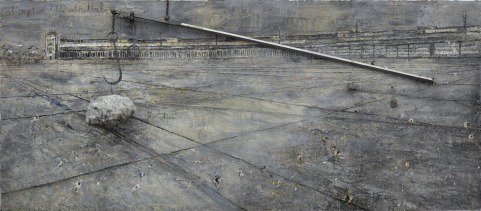Anselm Kiefer
dal 8/12/2011 al 25/2/2012
Segnalato da
8/12/2011
Anselm Kiefer
White Cube Bermondsey, London
Il Mistero delle Cattedrali. The title of the exhibition is taken from the esoteric publication by Fulcanelli, which claimed that the Gothic cathedrals of Europe had openly displayed the hidden code of alchemy for over 700 years. As with all Kiefer's work, allusions are never literal but reflect an ongoing interest in systems - mystical and material - which have evolved over centuries.

White Cube Bermondsey is pleased to present a new exhibition of work by the internationally renowned artist Anselm Kiefer. Staged across 11,000 sq ft of gallery space, 'Il Mistero delle Cattedrali' is the largest presentation of Kiefer's work ever made in London.
The title of the exhibition is taken from the esoteric publication by Fulcanelli (published in 1926), which claimed that the Gothic cathedrals of Europe had openly displayed the hidden code of alchemy for over 700 years. As with all Kiefer's work, allusions are never literal but reflect an ongoing interest in systems - mystical and material - which have evolved over centuries. Both title and exhibition reflect Kiefer's longtime fascination with the transformative nature of alchemy: 'The ideology of alchemy is the hastening of time, as in the lead-silver-gold cycle which needed only time in order to transform lead into gold. In the past the alchemist sped up this process with magical means. That was called magic. As an artist I don't do anything differently. I only accelerate the transformation that is already present in things. That is magic, as I understand it.'
All of the large-scale canvases on show use landscape as its starting point. Thereafter, Kiefer works on each of them rigorously and with intense physicality and some of the canvases are exposed to the elements. In addition, for this exhibition, many of the large-scale works have undergone an accelerated process of oxidisation. Consequently, images that may be seen to evoke the sublime are themselves subjected to the subtle but immense power of natural forces. 'You have to find a golden path between controlling and not controlling, between order and chaos' Kiefer has observed. 'If there is too much order, it is dead; if there is too much chaos, it doesn't cohere. I'm continually negotiating a path between these two extremes.'
As well as the over-arching theme of alchemy, Kiefer continues to wrestle with various history, notably twentieth century Germany. Among the most striking and monumental of all his recent motifs is that of Tempelhof Airport in Berlin. Finally closed in 2008, it is among the most charged and culturally loaded of buildings. Built in 1927 on land once belonging to the medieval Knights Templar, the airport was redesigned in the following decade as part of Albert Speer's master plan for the Nazi reconstruction of Berlin. The vast complex was intended as Hitler's gateway to Europe and as a symbol of his 'world capital', Germania. It was never finished but witnessed military activity during the Cold War and was seen by many as a forerunner of the airports of the late twentieth century, in its grandeur and ambition. In Kiefer's vast canvases, Tempelhof is transformed into a latter day cathedral, or a mystical site of aspiration, of absurdity, even apocalypse.
Anselm Kiefer was born in 1945 in Donaueschingen in Southern Germany. He has lived and worked in France since 1991. Exhibitions of his painting, sculptures, drawings and installations have been staged extensively over the past four decades and his work is included in the world's most prestigious public and private collections. Recent projects include the Grand Palais, Paris and Guggenheim Bilbao. In 2007 Kiefer became the first artist to be given a permanent commission to install work at the Louvre, Paris since Georges Braque some 50 years earlier. In 2009 he created an opera, 'Am Anfang', to mark the 20th anniversary of the Opéra National de Paris. In November 2011 he opened 'Shevirat Ha-Kelim' at the Tel Aviv Art Museum, the inaugural exhibition in the Herta and Paul Amir Building.
An illustrated catalogue with an essay by Jay Winter will be published in spring 2012.
Opening 9 december
White Cube
144 – 152 Bermondsey Street London
Opening times: Wednesday – Saturday 10am – 6pm Sunday 12pm – 6pm Closed Mondays and Tuesdays
Admission free



